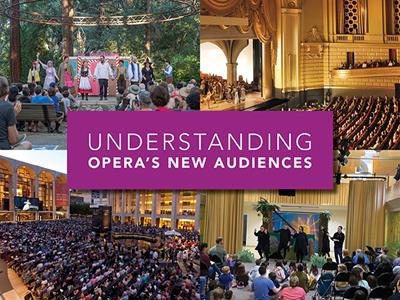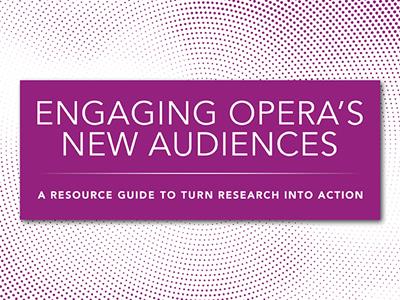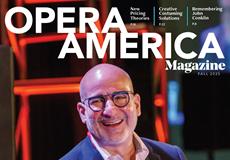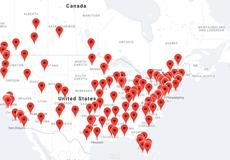Strike Gold by Starting Simple: A Response to Understanding Opera’s New Audiences
The following essay is a response to OPERA America's Understanding Opera’s New Audiences report and how its findings can inform strategy across the field.
When OPERA America’s Understanding Opera’s New Audiences study was released, I had already been thinking a lot about “new.” My wife and I had a new baby at home, only six weeks old, when I read the report on family leave over my kitchen counter. Despite my family’s background in music and decades of experience in arts and culture, I’m “new” to opera and had only been working at Central City Opera for four months when the study was published. “New” was all around me.
Meanwhile, Central City Opera is a 93-year-old company in a 150-year-old venue. “New” is tricky for us at CCO. Our instinct — usually for good reason — is to lean into the past, to tap into the rich history of our venue, stretching back to the gold miners of Colorado who built our beautiful opera house in 1878. I felt a lot like those miners as I cracked open this massive study — there was an almost overwhelming amount of treasure in the 60+ pages of findings. The instincts I built up over a decade spent at TRG Arts before coming to CCO guided me at first: “What is actionable?”
Because of research I had already conducted, I knew that 37% of our 2024 ticket buyers were attending CCO for the first time. Of those first-time buyers, 42% were Gen X, Millennial, or Gen Z (compared to just 20% of our returning audiences). So, while it was interesting to compare our first-timers to the field’s, I merely skimmed until I hit section 4: “What would bring them back”?
I relish the fact that this study is not just about the attraction of new audiences, because as the numbers above suggest, our art form does that very well. As much as we feel afraid that the stigma of opera is too intimidating, or “turns audiences off,” there are interested audiences willing to take the leap into opera for the first time — as evidenced by the group chat a group of my friends started a few weeks after I began working at CCO to plan an outing to the opera. As I read the study, I was reminded of the questions raised in this group chat: “So do we need to dress black tie?” (New-to-Opera attenders are 13% more likely to want an excuse to get dressed up.) “Is it gonna be in English?” (New-to-Opera attenders are 9% less likely to know translations will be available.) “The balcony is going to be a bit more relaxed, right?” (New-to-Opera attenders are 7% less likely to feel like they fit in at the performance.) But, despite these uncertainties, the allure of the opera was strong. Why, I thought?
This study points to an answer: 59% of New-to-Opera attenders say that their motivation to attend was driven by the desire to “try something new.” Another fact from the research: 82% of New-to-Opera buyers cited “seeing a famous or well-known opera” as having the highest impact on their interest to attend.
This last point was met with dismay and challenged by many in the field, but to me, it was a shining beacon, a huge “green light.” Despite the fact that inside the industry we may be tired of doing Barber and Bohème, centuries of fame and momentum keep those works alluring to new audiences. Of course someone who is new to opera is interested in “inherited repertoire” — their entry into our world is naturally going to start with some of the most famous and enduring music in human history. Why would they roll the dice on something that — however artfully done — hasn’t passed the litmus test of time?
Reading this study, along with my experience playing “concierge” for my friends’ group chat, left me with this question: Once a new customer has “gotten their opera on,” what will leave them wanting more?
My desperate hope is that every first-timer who comes to Central City Opera would answer that question by saying “the magic of the intimate jewel-box theater” or “breathing in the rich history of Colorado’s past while enjoying world-class performances” or quoting any piece of brilliantly written copy from our website.
But the truth is, compared to the amount of effort we spend on our existing audiences, we haven’t done much of anything to cater to our first-time audiences. We invited them, and they came, but what did we do to curate the experience for newcomers before, during, and after the show?
This question drove me to conversations internally, crossing every department at our organization, because the findings are clear: This is not just a marketing problem. This requires us to rethink how we wield our resources, expertise, and time across every team. I held conversations about budget, hiring, and resources with our leadership team and board (especially the chair of our External Affairs Committee). I had strategy sessions with our development team tapping their experience in receptions and events; wide-ranging reflections with our box office about the kinds of conversations we have with customers who have never been before; and with our artistic director, data- and passion-fueled debates about what kind of programming attracts new audiences — but more importantly, what kind of programming gets audiences to stick. Not all of these conversations stemmed directly from the research, but the report got us started. The findings were always there in the back of my head, and sprinkled into the conversations, pushing us toward progress.
The commitment I’m making to fostering our relationship with New-to-Company attenders has three pillars:
- We will listen. Our post-show survey includes two simple questions (a 0–10 satisfaction ranking and an open text box to describe your score) and has an incredible response rate — upwards of 20%, which I’m continually gobsmacked by and grateful for. Our customers provide us with invaluable feedback and findings. But I’m embarrassed to say, we do zero segmentation of this survey. This season, we will segment our first-time attendees out and weigh their feedback appropriately.
- We will bring our A-game, before and after the curtain. One thing I know in my bones, even without a post-show survey, is that audiences love what we do on stage. Ninety-three percent of New-to-Opera attenders in the study found the musical performances to be outstanding. We throw incredible receptions for long-time supporters and deep-pocket donors before and after shows. We make sure traveling artists and faculty are oriented to our campus and venues before they arrive. That same care and attention must be applied to our new audiences, setting them up for a positive experience before they arrive and as they depart, and fostering the relationship thoughtfully after their night at the opera is over.
- We will “date” before marrying. The old adage “date your patrons before you marry them” is one we’ve likely all heard. But despite that obvious wisdom, it requires constant effort to avoid falling into the trap of immediately sending a fundraising ask to a first-time attendee. Anecdotal evidence suggests that we have sometimes asked patrons for money before they’re even aware we’re a nonprofit. Our follow-up to new audiences will experiment with and measure what kind of follow-up leads to a second date and what efforts turn new audiences off. We need to give ourselves permission to try, measure, and learn from failure.
When gold was first discovered in Central City in 1859, some 20 years before the construction of the Opera House, it wasn’t found in a mine deep under the earth. John Gregory found it simply panning in the gulch where he could see it with his naked eye. Similarly, we can strike gold by starting simple. In reading this research study, I encourage you to start simple. Find one data point that excites you, or scares you, or moves you, and from that data point, talk to your team. Make a plan to change. Start small. Like the gold in Central City, the next generation of support for our art form is all around us. We just need to stick our pans in the creek.
This essay was commissioned with support from the Dr. M. Lee Pearce Foundation.

Understanding Opera’s New Audiences: Research Report
Read the report of a national research study into the motivations, experiences, and barriers faced by new opera audiences nationwide.

Engaging Opera's New Audiences: Turning Research into Action
Read the companion resource guide to turn first-time operagoers into loyal fans with insights and tactics from OPERA America.

Meet Them Where They Are: A Response to Understanding Opera’s New Audiences
Katherine Powers shares how she derives meaning from OPERA America’s newcomer study for her work at Pacific Opera Project

Adam Scurto
As Managing Director of External Affairs at Central City Opera, Adam's mission and focus are to grow both new audiences and the loyalty of existing customers and donors at CCO.





